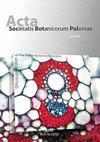Traditional Knowledge of Wild Edible Plants of Biga (Çanakkale), Turkey
IF 0.8
4区 生物学
Q3 PLANT SCIENCES
引用次数: 11
Abstract
Biga, located in the southwestern part of the Marmara Region of Turkey, is the largest district of Çanakkale. Wild edible plants and the ways in which they are used in Biga have not previously been documented. This ethnobotanical study of Biga was conducted between June 2011 and September 2014. In this study, we recorded information such as the local names of plants, the manner in which they are used, and the particular parts of the plants used. The cultural importance index was calculated for each taxon. One hundred and sixty-five interviews were conducted in 49 villages. The study revealed that 55 wild edible plant taxa belonging to 41 genera are used in this area. The most frequently used families are Rosaceae, Lamiaceae, Polygonaceae, and Apiaceae. The genera that represented the greatest number of taxa included Rumex (six taxa), Thymus, Eryngium, Mentha, Oenanthe, Papaver, Prunus, Rubus, and Urtica (each containing two taxa). The most culturally important species were Urtica dioica, U. urens, Malva sylvestris, Thymus longicaulis subsp. longicaulis var. subisophyllus, and Cornus mas. Local people consumed plants in the form of vegetables, fruits, beverages like herbal teas, spices, and other products. Edible parts of plants included leaves, aerial parts, young stems, and fruits. The results of our study showed that even in districts located close to cities, the use of wild edible plants still continues.土耳其比加(Çanakkale)野生可食用植物的传统知识
比加位于土耳其马尔马拉大区西南部,是恰纳卡莱最大的地区。野生可食用植物及其在Biga中的使用方式以前没有记录。这项对比格的民族植物学研究于2011年6月至2014年9月进行。在这项研究中,我们记录了植物的当地名称、使用方式以及使用植物的特定部位等信息。计算了每个分类单元的文化重要性指数。在49个村庄进行了一百六十五次访谈。研究表明,该地区共有41属55个野生食用植物类群。最常用的科是蔷薇科、Lamiaceae、Polygonaceae和Apiaceae。代表最多分类群的属包括Rumex(六个分类群)、Thymus、Eryngium、Mentha、Oenanthe、Papaver、Prunus、Rubus和Urtica(每个包含两个分类群。最具文化意义的物种是二尖苔草、乌伦苔草、大叶锦葵、长茎百里香亚种。长茎变种,和山茱萸。当地人食用蔬菜、水果、草药茶、香料等饮料和其他产品等形式的植物。植物的可食用部分包括叶子、地上部分、幼茎和果实。我们的研究结果表明,即使在靠近城市的地区,野生可食用植物的使用仍在继续。
本文章由计算机程序翻译,如有差异,请以英文原文为准。
求助全文
约1分钟内获得全文
求助全文
来源期刊
CiteScore
2.00
自引率
10.00%
发文量
18
审稿时长
1 months
期刊介绍:
The journal has been published since 1923 and offers Open Access publication of original research papers, short communications, and reviews in all areas of plant science, including evolution, ecology, genetics, plant structure and development, physiology and biochemistry.

 求助内容:
求助内容: 应助结果提醒方式:
应助结果提醒方式:


